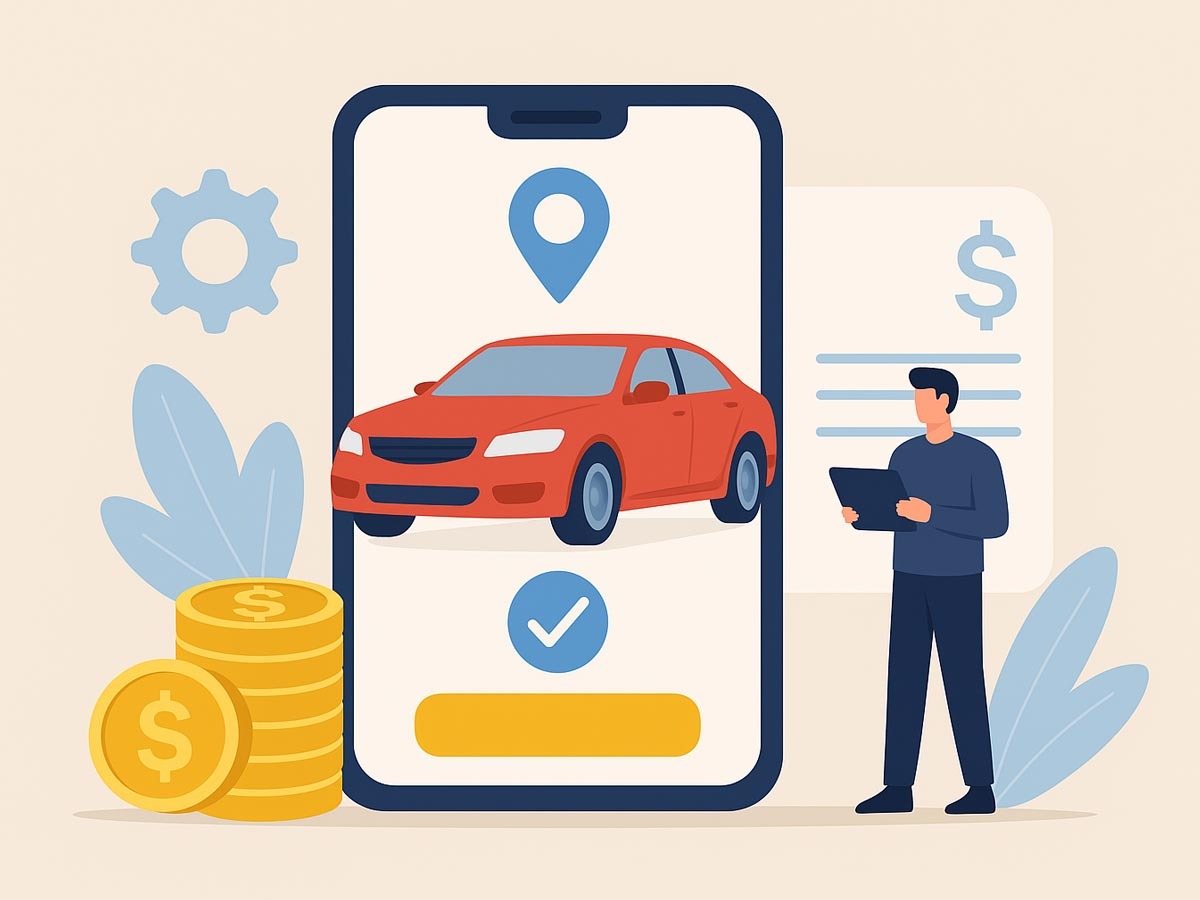How Much Does It Cost to Build a Car Rental App Like Turo?

-
Ankit Patel
- November 18, 2025
- 7 min read
The car rental market has changed rapidly over the past few years. What used to be a traditional service dominated by large rental companies has now shifted toward digital, convenient, and highly accessible on-demand solutions. Today, platforms like Turo have opened the doors for peer-to-peer rentals, giving users the freedom to book cars anytime, anywhere.
If you’re planning to start a digital mobility business, building a car rental marketplace app like Turo is probably one of the biggest ideas on your mind. And it makes sense — people today prefer convenience, transparency, and instant access when it comes to renting a vehicle. Traditional rental agencies simply cannot provide that level of flexibility.
That’s where platforms like Turo have changed the game. They created a marketplace where everyday car owners can list their vehicles, and consumers can rent them with just a few taps.
For anyone looking to enter the on-demand car rental industry, one of the first questions you’ll have is:
“How much does it cost to build a car rental app similar to Turo?”
To answer that, we first need to understand what building such a platform truly involves — from the essential features to the workflows and key decisions that influence the total cost.
So, let’s get into it.
◉ Online Car Rental Platform Market: Key Trends & Growth
When you’re building a Turo-style app, you’re not just targeting a niche — you’re stepping into a rapidly expanding global marketplace.
- The global car rental market was estimated at around $153 billion in 2025, and is projected to reach $324 billion by 2034.
- According to Grand View Research, the global car rental market is expected to grow at a CAGR of 10.5% from 2025 to 2030.
- More specifically, the peer-to-peer (P2P) car‑sharing market is expanding fast. According to Intent Market Research, it was valued at about $2.8 billion in 2024 and is expected to grow at a CAGR of 14.3% between 2025 and 2030.
- The car‑sharing market, which overlaps significantly with peer‑to-peer rentals, is also growing rapidly. According to IMARC Group, it was valued at $8.93 billion in 2024 and is expected to rise to $24.4 billion by 2033.
◉ What is Turo and How Does It Work?
Turo is a peer-to-peer car-sharing platform that connects car owners with people who want to rent a car. Instead of renting from a traditional agency, users can book vehicles directly from local hosts.
How Turo Works:
- Car Owners Become Hosts: Owners upload pictures of their vehicles, enter details like brand, model, features, price per day, availability, delivery options, and insurance coverage. The platform verifies the listings before they go live.
- Renters Search for Cars: Renters browse available vehicles based on pickup location, date, price, or car category. The app shows real-time availability so users know exactly which cars are ready for booking.
- Secure Verification Process: Turo verifies renter identities, driving licenses, and sometimes age eligibility. This builds trust and reduces the risk for car owners.
- Booking & Payments: Once a renter selects a car, they pay through the in-app payment system. Turo handles payouts to the hosts after taking a commission.
- Pickup & Communication: Some hosts offer home delivery or airport delivery, while others ask renters to pick up the car from a specified location. All communication is done inside the app.
- Trip Completion & Ratings: Once the rental period ends, the renter returns the car, and both parties leave ratings and reviews. This feedback loop helps maintain transparency.
This simple, seamless model is what makes Turo popular, and it serves as a great foundation if you plan to build a similar platform or a Turo app clone.
◉ Essential Features of a Turo-Style Car Rental App
A car rental app like Turo must prioritize three things: convenience, trust, and transparency. The app should feel natural to use — whether you’re booking a car or listing one.
Let’s break down the essential features:
1. User App Features
Smooth Registration and Profile Setup
Users expect a quick onboarding process. A good app allows them to sign up using email, mobile OTP, or social login. The purpose is simple: reduce friction and get them browsing cars in seconds.
Search & Filters
Search is the heart of any car rental platform. Users should be able to apply filters like car model, fuel type, transmission, budget, seating capacity, distance, host rating, and availability. A smart search filter helps users instantly find the perfect car without scrolling endlessly.
Real-Time Availability & Calendar View
If a car appears available, it must be actually available. Real-time calendars avoid booking conflicts and help the user understand which dates are open or blocked.
Easy Booking & Scheduling
A modern car rental app must offer instant booking, scheduled bookings, and even hourly rentals if needed. The entire process should feel similar to booking a hotel room online — quick, clean, and straightforward.
Multiple Payment Options
Supporting multiple payment methods (credit card, debit card, UPI, wallet, etc.) makes the platform universal. Secure payment gateways are a must to handle large transactions.
GPS Navigation & Pickup Assistance
Once a user books a car, they should be able to see directions to the pickup point. In case the host offers delivery, the navigation feature becomes even more helpful.
Ratings & Reviews
A star-based rating system builds trust between renters and hosts. Additionally, users should have access to help centers or live chat for queries or emergencies.
2. Host App Features (Car Owners)
Vehicle Listing & Management
Hosts need clear tools to upload photos, documents, set prices, update availability, and specify pickup rules. The listing process should be easy enough that any non-technical car owner can manage it themselves.
Accept/Reject Request
Hosts must be able to accept or decline booking requests, set custom pricing for different days, and update availability instantly.
Earnings Dashboard
A transparent earnings dashboard helps hosts track income, payouts, and upcoming bookings. This builds long-term trust and loyalty.
Chat & Message
Direct chat between hosts and renters helps resolve pickup details and other questions without leaving the app.
3. Admin Panel
The admin panel is the control center of the entire system.
User & Vehicle Verification
Admins must verify car documents, insurance papers, driving licenses, and identities to maintain safety standards.
Commission & Pricing Management
You can set platform fees, taxes, seasonal pricing rules, cancellation fees, and discounts directly from the admin panel.
Dispute Resolution
Accidents, delays, or misunderstandings can happen. The admin panel should have tools to manage disputes efficiently.
Analytics & Reports
You can track daily bookings, top-performing hosts, revenue trends, user behavior, and operational bottlenecks.
Together, these features create a seamless experience and make the app usable for both renters and hosts.

◉ Cost to Develop a Car Rental App Like Turo
Let’s come to the main question: How much does it cost to build an app like Turo?
The truth is, there’s no fixed budget for building a Turo-style car rental marketplace. The cost depends entirely on how complex you want the app to be, which features you include, the quality of the UI/UX, and the on-demand app development company you choose.
However, to give you a rough estimate, the average cost to develop a car rental app like Turo ranges between $20,000 to $100,000+.
Below is a simple breakdown:
| App Types | Features | Estimated Cost |
| Simple App | Basic features | $20,000 – $30,000 |
| Mid-Complex App | Medium-complex features | $30,000 – $50,000 |
| Advanced / Turo-Level App | Highly complex features | $50,000 – $100,000+ |
Want Something More Affordable?
If you feel this budget is too high or you’re not ready to invest in a full custom build app, there is a more cost-effective option. You can go with a Turo clone app, which comes with pre-built features of a car rental marketplace and can be customized as per your requirements. These readymade solutions cost significantly less and can help you launch your car rental app within 10 days.
It’s a smart option for startups or entrepreneurs who want to enter the market quickly without spending big money on custom development.
◉ Factors Affecting Car Rental App Development Cost
The final cost depends on several technical and business factors. Let’s go deeper into the most important ones:
App Features & Complexity
The number of features and how complex they are is the biggest cost driver. Basic features like user login, car listings, and booking are affordable. But advanced features—such as real-time availability, ID verification, automated pricing, insurance integration, in-app chat, or GPS tracking—take more development time and increase cost.
Simply put:
More features = More time = Higher cost.
Platform Choice (Android, iOS, or Both)
If you decide to launch an app for both Android and iOS, the cost goes up because developers need to build and test for two systems. Using cross-platform frameworks like Flutter or React Native can help reduce costs by letting you use a single codebase, while native apps cost more but give the best performance.
UI/UX Design Requirements
A clean, easy-to-use interface is essential for any car rental marketplace.
If your design is simple and minimal, the cost stays lower. But if you want a modern, highly interactive UI/UX with custom elements, animations, and premium visuals, the design cost goes up.
Good design improves user trust, especially when people are renting cars from strangers.
Development Team Location
Where your development team is located directly impacts cost. Developers in the US or Western Europe charge much higher rates compared to teams in India or Eastern Europe.
Third-Party Integrations
Car rental apps rely on multiple third-party APIs, such as:
- Maps & navigation
- Payment gateways
- SMS/OTP verification
- Document scanning
- Insurance & pricing tools
These integrations improve user experience but add extra licensing and development costs.
Security & Legal Compliance
Car rental apps handle sensitive data like IDs and payments, so they must meet security and legal standards. Implementing encryption, safe login methods, and data protection compliance adds extra time and increases the overall development cost.

◉ Monetization Strategies for Your Car Rental App
A car rental marketplace like Turo can generate revenue in multiple ways. Here are the most effective monetization methods you can use:
1. Commission on Bookings
This is the most common model. You earn a percentage from every successful rental made through your platform. The more bookings your app handles, the higher your revenue.
2. Host Listing Fees
You can charge car owners a small fee to list their vehicles or offer premium listing plans that give better visibility.
3. Subscription Plans
Both users and hosts can unlock extra perks with monthly or yearly subscription plans, like priority support, lower service fees, or exclusive premium features.
4. Surge or Dynamic Pricing
Increase your earnings during peak hours, holidays, or high-demand periods by adding automated dynamic pricing.
5. In-App Advertising
Allow relevant brands like car accessory shops, insurance companies, and service centers to promote their services within your app, helping you earn revenue through ads.
6. Insurance Partnerships
Partnering with insurance providers lets you earn a fee whenever users purchase insurance coverage during bookings.
7. Cancellation Fees
Allow users to cancel bookings, but apply a fee for last-minute cancellations.
◉ Final Thoughts
At the end of the day, building a car rental app like Turo is all about clarity. Know what you need, know what you can afford, and build a version that gets you into the market without delay. The costs will always vary, but the real advantage goes to the business that starts, learns, and improves faster than the competition. If you can do that, the app you launch today can become the platform users rely on tomorrow.
You may also like

How Multi-Agent AI Systems Are Powering On-Demand Apps
-
Ankit Patel
One AI agent can answer a question. But can it handle the chaos of real-time demand, delivery delays, balance supply, and customer feedback—all happening at once? That’s the challenge behind most on-demand apps today. A single model can automate a process, but it often can’t reason across multiple workflows or adapt to fast-changing conditions. As… Read More

How Much Does It Cost to Build an App Like Teladoc?
-
Ankit Patel
The world of healthcare is changing faster than ever. Patients no longer want to wait in long lines or travel miles just to meet a doctor. They want quick, remote access to trusted healthcare services — and that’s exactly what Teladoc offers. Apps like Teladoc have made it possible to consult doctors from the comfort… Read More

How Much Does It Cost to Develop a Telemedicine App?
-
Ankit Patel
A decade ago, seeing a doctor meant hours in a waiting room, piles of paperwork, and endless phone calls. For millions of people in rural areas, even basic medical care was a luxury. Patients had to travel long distances, lose work hours, and hope that their medical history was accurate and available. Today, healthcare looks… Read More






